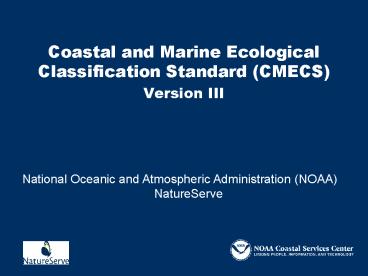Coastal and Marine Ecological Classification Standard CMECS - PowerPoint PPT Presentation
1 / 14
Title:
Coastal and Marine Ecological Classification Standard CMECS
Description:
Coastal and Marine Ecological Classification Standard (CMECS) Version III ... Humboldt Bay. Long Island South Shore. Marathon Workshop (Allee et al. 2000) ... – PowerPoint PPT presentation
Number of Views:135
Avg rating:3.0/5.0
Title: Coastal and Marine Ecological Classification Standard CMECS
1
Coastal and Marine Ecological Classification
Standard (CMECS)
- Version III
National Oceanic and Atmospheric Administration
(NOAA) NatureServe
2
Issues
- Currently over 100 systems used for classifying
benthic habitats - Few systems used by more than one
party/advocate - Most systems tied to a particular technology
- Ultimate purpose of most systems not well
defined - Most coastal/marine mapping done on a local or
state level - No existing marine or pelagic standard beyond
- Cowardin
Diaz, Solan Valente, 2004Journal of
Environmental Management
3
Needs
- A universally-accepted classification system
- OR
- A framework/standards that all classification
systems can report to
4
Goals of the CMECS Standard
- Support conservation efforts
- Facilitate standardization Glossaries,
vocabularies - Build on existing classifications
- Be applicable at various scales local, regional,
and continental - Visualization Multi-dimensional maps in GIS
- Foster broad audience adoption
- Integrate with global systems (EUNIS, BioMar)
5
Objectives of CMECS
- Capable of including all four seascape components
in one structure, including water column - Technology independent
- Not geographically constrained
- Lower levels to remain open with
- process for adding new units at
- the lower levels
6
Current Structure of CMECS
- Benthic Cover (BCC) Describes the
geomorphologic, physico-chemical, and biological
composition of the coastal and marine substrate - Water Column (WCC) Describes the structure,
patterns, processes, and biology of the overlying
water column - Geoform (GFC) Describes the major geomorphic or
structural characteristics of the coast and
seafloor at various scales - Sub-benthic (SBC) New addition to describe the
sediments and biology within the benthic
substrate - Modifiers Additional attributes that further
describe units in the major components
7
CMECS Components
GeoForm Component
Water Column Component
Benthic Cover Component
WCC
Sub-Benthic Component
8
What are the intended applications for
CMECS-Compliant Data?
- Resource inventory
- Conservation and restoration planning
- Individual habitat queries
- Conservation status assessment and monitoring
- Ecosystem services management
- Regional and national resource assessment
- Data sharing facilitation
- EFH delineation
9
Pilots and Current Testing
Desktop Pilots
Current Projects
- Redfish Bay
- Mobile Bay
- Florida Bay
- South Atlantic Bight
- Mass CZM comparison
- Humboldt Bay
- Long Island South Shore
10
Development Process To-Date
- Marathon Workshop (Allee et al. 2000)
- Charleston Workshop (Madden et al. 2003)
- CMECS I (Madden and Grossman 2004)
- CMECS II and CMECS glossary (Madden, Grossman,
and Goodin 2005) - Columbia River Pilot (Wright et al. 2006)
- Charleston Workshop (NOAA/NS 2006)
- Draft Version III (Madden et al. 2008)
- Mapping Guidance Criteria Report (Green et al.
2008)
11
Integration with Existing Standards
- FGDC Standards
- Adopting Cowardin (Nat. Wetland Std.) in areas
of overlap and reconciling definitions - Incorporating National Vegetation Classification
system elements in BCC Group and Biotopes
12
Integration with Existing Standards
- Other Commonly Used Systems
- NOAA Corals (Coral ecosystems)
- NOAA NERR System (small nearshore aquatic and
coastal terrestrial areas) - Greene et al. (Pacific deepwater marine
geoforms) - MapCoast (Shallow subaqueous soil areas)
- System for Classifying Habitats in Estuarine and
Marine - Environments SCHEME (Florida state waters)
13
Adoption by Other National/International Efforts
- National Fish Habitat Action Plan
- National Park Service
- IABIN
- OBIS
- Gulf of Mexico Alliance
- West Coast Governors Alliance
14
A Standard that Makes a Difference
- Implementation guidance will accompany the
standard - living documents
- Crosswalk tools to allow users to integrate
information from - different sources
- Process for adding new units (Biotopes)
- Training for users































